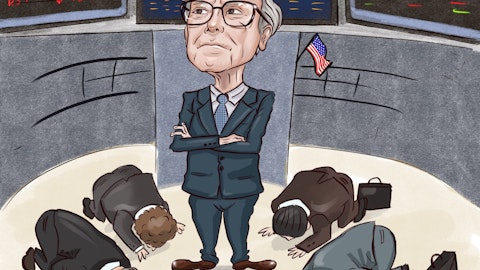Vivek Juneja: I wanted to just clarify the reorganization a little bit. So Jane, I heard you say, to keeping North Asia, North Asia and South Asia heads. So did you just get rid of the Asia head and get rid of the product heads where product heads in each country, we’re reporting to a regional product head. So – is that dotted line is no longer there? What’s going on there? And when you get rid of all the monthly management reporting, what are you planning to replace that with from your management? Your MIS perspective?
Jane Fraser: So let me take the second one first. I’m not planning on replacing it with anything. We don’t need them. We’re no longer running consumer franchises in the countries. Instead, we’ve got global businesses that are operating very consistently in the individual geographies. So we just don’t need replace them. And it enables us just to have the legal entity financial management that we need. And then our internal reports get greatly simplified same as they get greatly simplified by taking out ICG and PBWM is another – eliminating that layer also eliminates a lot of different reports. So the wonderful answer is nothing, a simplicity. The first question was about, okay, help you understand what we’ve done. So on the geography front, we have done two main things already.
One is we put – we’ve eliminated the regions and I’ve just put a single international head reporting to me. So that makes it much simpler for me. I have one international head, and then he will help us manage the geographies collectively. The second piece is we’ve really narrowed the mandate of geography to delivering to our clients and covering our clients in their countries and secondly, the legal entity management. And otherwise before, we had a huge amount of management on shadow P&Ls and different – a lot of very heavy committee structure. That was necessary because the business was still very local as a retail bank, a local credit card business, a local onshore wealth business. They’ve gone. It’s just serving multinational, the subsidiaries are multinationals and in some markets, the investors and the wealth clients in some markets.
And that’s a much simpler business to manage. So we could get rid of the regional there, and we just jumped straight down to the clusters that we have today, but they too have less of a mandate than they had before, a much more focused one. And the bit that I’m excited about it is not just, yes, this makes it much simpler to manage but it also helps us really focus on the global network. Now our geographies and our banking organizations sitting together on the same management structure, collectively accountable for serving and delivering against our core client base. And they’re in one team to do it, it just makes it much easier. Does that give you a feel what else, Mark?
Mark Mason: The other thing, Vivek, that I think is important here is we really want to spend a little bit more investment and time on the client lens in terms of the financial reporting, right? Because as Jane talked about, we talked about the synergies across the franchise that we can capture the ability to leverage the offering we have for those different client segments. So looking at that P&L, looking at those returns, looking at that growth opportunity, through that client lens will be something where we want to enhance the metrics that we have already around that so that we can capture that upside.
Jane Fraser: And around the other piece that I think is also just an important point. Globalization is changing it. We’re seeing these lanes all changing, food, trade, financial flows, et cetera. By actually having a single international organization and then the different clusters, North and South Asia, Europe, U.K., LATAM, Middle East, Africa. The connection points between them are really changing at the moment. And so this makes us much more agile in our delivery of the global network because I think it’s much more in line with how the world is operating today.
Operator: And our next question comes from Saul Martinez with HSBC.
Saul Martinez: Hi, there. So I wanted to continue on the threat of normalization of credit losses? And you guys have – I guess your guidance is implying that branded cards and retail services get back to more normalized levels by year-end, which is a decent sized uptick over the levels you had in the third quarter. So I kind of want to know what’s driving that view? But more importantly, I guess what does that imply going forward? And does it imply that we get to more – something more like above-trend losses? Because I would think we still have some seasoning to go in the late 2021 and 2022 vintages. And not only that, we’re talking about this in an environment where we still have pretty extraordinary labor market. So if you could just give us a little bit more color on just your expectations on credit losses and whether there’s maybe a little bit more risk than we’re thinking in terms of losses trending to something that is a bit higher than what we normally – what are more normalized levels?
Mark Mason: Yes. So let me start and that and Jane, if you want to chime in, that’s fine. I think what I’d point you to is Page 24 in the deck that we have because it gives you a nice snapshot of how both the loss rates have been trending, but also how the delinquencies have been trending. And you can see that the delinquencies have been trending up, and that kind of gives us a good indication of where loss rates are likely to trend in the next quarter or so. And so at 2.72 unbranded cards and 4.53 on retail services, we can see that we’re likely to end up at about that normalized rate by the end of the year, getting up to the 3% to 3.25%, 5% to 5.5% pre-COVID normalized NCL rates. Our expectation is that as we go into ’24, to the point that you’ve made, depending on the macro environment, we’re likely to see this tick up above those pre-COVID normalized rates.
As we see a slowdown in the economy, again, subject to what the macro looks like before then kind of settling down at some point down the path. And so yes, we do see that tick up. This is, again, as advertised, so to speak, as we would have expected. And we have reserves, significant reserves for both of these portfolios to account for those loss expectations. So in branded cards, we sit with an ACL to loan reserve of 6.3% in retail services we have 11% and Jane mentioned earlier that the losses in retail services ultimately get shared with partners. And so while we would expect this to normalize and mature, so to speak, we feel very well reserved for what that might look like.
Jane Fraser: And our portfolio [technical difficulty] old Citi. It’s very different in terms of our consumer credit exposure. And I think what you’re hearing from us is, this is – this should all be very manageable. We’re not there’s no alarm bells going off at Citi around this. We’re being prudent. We’re being conservative around pieces and responsible on it. But there’s no alarm bell ringing. And I think there may be a bit of a disconnect from some of the questions out there versus how we’re feeling. We’re just not seeing the data that is overly concerning. It’s manageable. This is all very manageable, and we’re being prudent about it as you’d expect us to be.
Operator: And our next question comes from Mike Mayo with Wells Fargo.
Mike Mayo: Hi. Thanks for the follow-up. From your initial answer, Jane, I hear you with the restructuring, deconstructing city to global lines, delayering of management and decluttering reporting, and when you add it all together, we’ll get some numbers in January. But as it relates to your return targets and efficiency targets for 2025 and 2026, consensus is about one-third below what you target. And frankly, I have not spoken to one investor who thinks you’re going to get those targets and maybe you would want to revise those lower in some way or maybe to be determined? Or what’s your degree of conviction of getting to those targets or at least getting above your cost of capital? Thank you.





